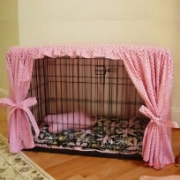Unleash the Magic of Crate Training: Dogs Discover their Inner Zen Den
We’re diving into the wonderful world of crate training for dogs. Yep, that’s right, it’s like doggie daycare but with a twist. I’m about to spill the beans on how to tackle separation anxiety and give your furball their own safe space to chill. Here at PetVilla, we try to create a home-like routine that includes the Dogs coming into our home in a climate-controlled bedroom to sleep in their while Boarding. Dogs get also get nap-time in a Crate during Dog Day Care.
The goal is that being in a House and hearing all the sounds talking, TV running, etc, helps your dog feel like home. So, it is important that your dog is crate-trained. Plus, we’ll chat about the power of positive reinforcement and why doggies love it. Are you ready for a belly rubbin’ good time? Let’s go!
Alright, let’s start with the benefits of crate training. Picture this: a serene oasis where your pooch can relax and learn some doggie discipline. We want them to feel all snug and secure, not like Houdini planning their great escape. That’s where the right crate enters the scene. We’ll dive into the ins and outs of choosing the perfect crate for your four-legged buddy.
Now, let’s talk about a common issue: separation anxiety. If your dog loses their mind whenever you step out for a second, we’ve got your back. We’ll explore how crate training can be a game-changer in curbing those frisky feelings. We’re here to teach them that being alone doesn’t necessarily mean the world is ending. Trust me, it’ll be a hoedown of joy when your furball masters the art of chilling on their own.
Oh, and get this – you can even use crate training to solve the mystery of potty training. No more indoor surprises or stepping on unexpected landmines! We’ll give you the lowdown on how to housetrain those adorable little rascals. Soon enough, they’ll be wiggling their butts in excitement to show off their newfound skills.
But wait, there’s more! You’ll also discover how crate training can save your sanity during travel adventures. Buckle up, because we’re about to dig into the nitty-gritty of navigating airports or road trips with your trusty crate-trained sidekick. No more barking like a maniac or chewing through seatbelts. We’re all about keeping it smooth, folks.
Now, let’s not gloss over the importance of positive reinforcement. Forget about yelling or shaking a newspaper – we’re all about rewards and treats! We’ll unleash the secrets of making training sessions a blast for your fur baby. Spoiler alert: it involves lots of belly rubs, ear scratches, and treats that’ll make their doggie tail wag with delight.
So, if you’re sick of coming home to a chewed-up remote control or walls littered with scratch marks, hang in there. We’re here to help you turn your furry tornado into a classy, crate-trained champion. Stick around, my friend, because we’re about to embark on a humorous journey of doggie obedience like no other. Let’s fetch some knowledge and unleash the laughter!
Let us start with the serious part:
- How to address Separation Anxiety
Dogs are social animals and can develop separation anxiety when left alone. Crate training provides them with a designated safe space, mimicking a den-like environment that offers security and comfort. Being enclosed in a crate while their owners are away helps alleviate feelings of abandonment and reduces destructive behaviours caused by anxiety. - Making the Crate a Safe Haven:
The process of crate training involves introducing dogs gradually to their crate and ensuring positive associations with it. Using treats, toys, and positive reinforcement, dog owners guide their pets to view the crate as a secure and relaxing place rather than a form of punishment. Consistent training sessions help dogs understand that the crate is their own space, encouraging them to willingly enter and stay there without feeling anxious. A Dog Crate should allow the Dog to stand and still have some space over his head (maybe a hand-wide). - Successful Crate Training Strategies:
- Introducing the crate gradually: Start by placing the crate in a familiar area and gradually incorporating it into the daily routine.
- Positive reinforcement: Offer treats, praise, and rewards when the dog willingly enters the crate or demonstrates calm behavior inside.
- Gradual increase in time spent inside: Begin with short periods and gradually extend the duration, allowing the dog to become accustomed to longer intervals inside the crate.
- Utilizing crate training for meals: Feeding dogs inside the crate creates positive associations and enhances their comfort level.
- Start to cover the Crate at one point, so that it is dark like in a safe cave.
- Suitable Crates and Materials:
Opt for crates that provide ample space for the dog to stand, turn around, and lie down comfortably. Wire crates with removable dividers are adjustable and allow for growth. Additionally, consider using soft bedding or familiar items with the dog’s scent to enhance their comfort. - Enhanced Obedience and Discipline:
Crate training contributes to a dog’s overall obedience and discipline. By providing a structured environment, it establishes boundaries and routines that positively impact their behavior. Dogs learn to control impulses and reduce destructive tendencies, making them more reliable companions. - Benefiting from Crate Training:
Crate training is applicable to various breeds and age groups. Puppies, in particular, benefit from crate training as it aids in housetraining, prevents accidents, and helps establish a routine. Additionally, dogs that are crate trained are generally more adaptable during travel, making it easier for owners to transport them via plane or board them at kennels. - Addressing Behavioral Issues:
Crate training can be a valuable tool in addressing behavioral issues such as destructive chewing or excessive barking. When dogs are properly crate trained, it discourages them from engaging in destructive behaviours by providing them with a safe and controlled space, reducing the likelihood of them engaging in problematic actions.
In the world of crate training, perseverance pays off – both for you and your furry friend. Armed with these valuable resources, you’ll soon be a crate training maestro, guiding your dog into the realm of peaceful slumbers. Embrace the art of crate training like a dog embraces a new bone, and before you know it, bedtime will be a harmonious symphony of snores and sweet dreams. So grab that crate, channel your inner dog whisperer, and let the crate training adventure begin! Just remember to avoid reenacting any Hollywood prison break scenes involving a crate and a determined canine – we’re aiming for happy, restful sleep, not an epic escape plot!
Here some resources, when you would like to look more into the topic:
- SPCA New Zealand – How to Crate Train a Dog
- American Kennel Club (AKC) – Crate Training Guide: The AKC provides a comprehensive guide on crate training that covers everything from choosing the right crate to troubleshooting common issues. Visit their website at akc.org.
- The Humane Society – Crate Training: The Humane Society offers a step-by-step guide to crate training your dog, as well as tips on creating a positive association with the crate. Check out their website at humanesociety.org.
- Cesar’s Way – Crate Training 101: Cesar Millan, renowned dog behaviorist, shares his insights and techniques for successful crate training on his website. Visit cesarsway.com for his crate training advice.
- YouTube: There are several YouTube channels dedicated to dog training that have helpful videos on crate training. Some popular channels include Zak George’s Dog Training Revolution, McCann Dogs, and Kikopup.
- Look out for our local Dog Training Classes or Trainers like Pawsitive Behaviour, Balanced K9 and Veterinary Behaviourist Services NZ




